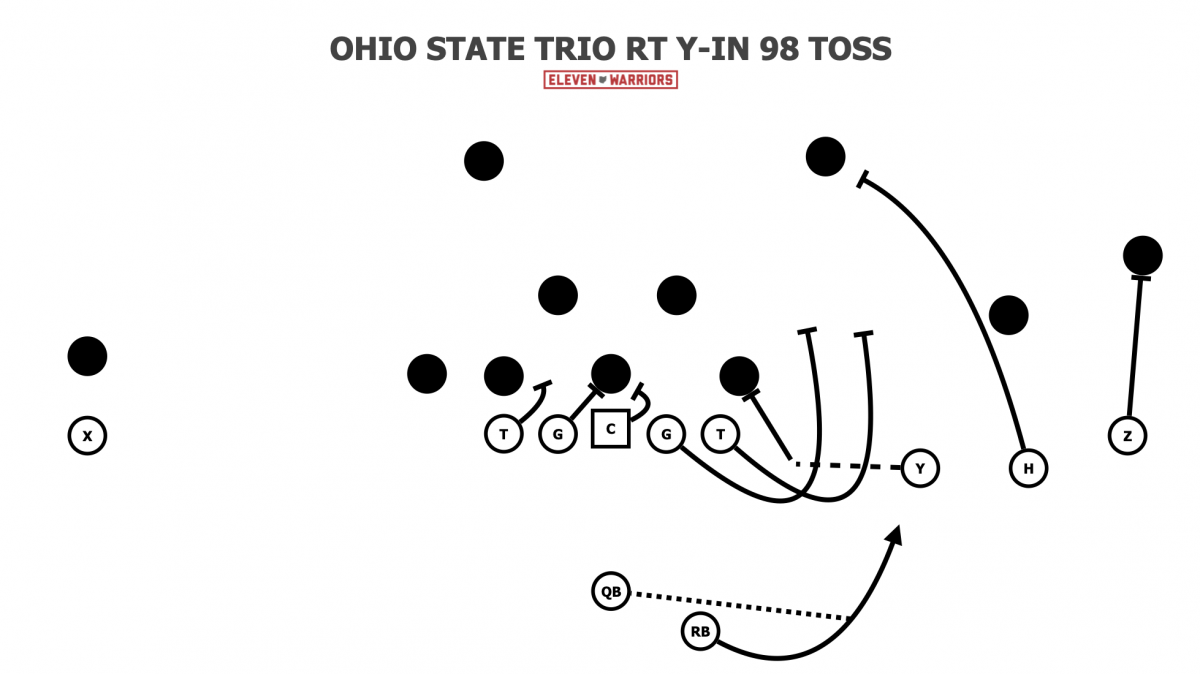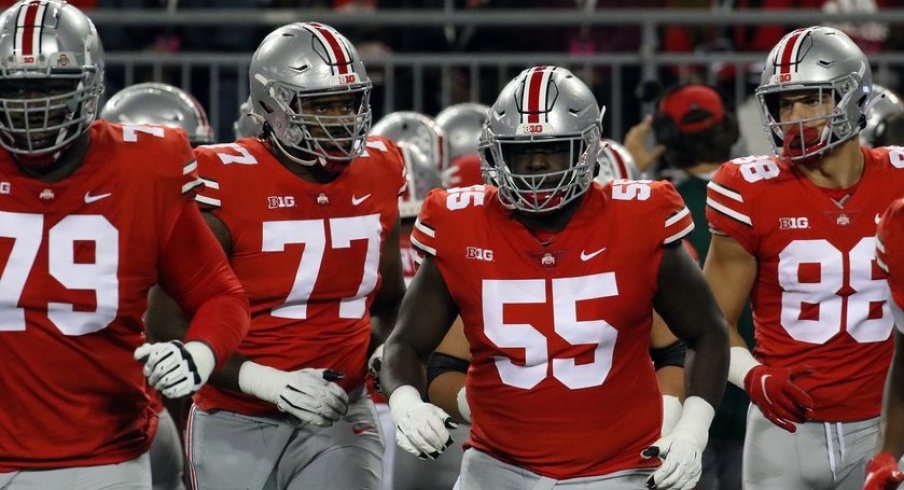There's been a lot to talk about this September.
First, there was the quarterback derby, which included a surprising late entry.
Then, there were all the concerns with the defense and the unofficial demotion of that unit's leader and play-caller.
Then, there were questions about fan attendance in Ohio Stadium, followed by the news of C.J. Stroud's injury and the subsequent debut of Kyle McCord in a Buckeye uniform.
And, of course, there were the transfers of veteran linebackers Dallas Gant and K'Vaughan Pope, the latter of which was the headline story for many following Ohio State's dominating win over Akron Saturday night.
But lost in all of this is the fact that the Buckeyes have quietly produced one of the nation's best offenses through the season's first trimester. Following a 59-point, 662-yard performance against the Zips, Ryan Day's squad ranks second only to Ole Miss in yards-per-game with an average of 559.3. Perhaps even more impressive is Ohio State's FBS-leading 8.6 yards-per-play, the highest-such mark since Day arrived in Columbus.
That's right, every time the Buckeyes simply snap the ball this season, they gain 8.6 yards on average. Just let that sink in for a second.
TreVeyon Henderson has been the surprise bright spot for this unit, breaking the OSU single-game freshman rushing record and stealing the starting running back job away from Master Teague and Miyan Williams in a manner reminiscent of Maurice Clarett in 2002. But Henderson, Stroud, and the rest of the Buckeye playmakers wouldn't have such gaudy numbers without the work of their offensive line, which has quietly become one of the nation's best.
That unit has faced plenty of adversity of its own this year, as well. Position coach Greg Studrawa was revealed to have missed multiple games due to back surgery, often working from a golf cart in practice and relying on graduate assistant Kennedy Cook to lead drills.
Additionally, presumed starting center Harry Miller has missed all four games this season, with a return date still unknown. Meanwhile, the most-tenured member of the group, Thayer Munford, has missed the last two contests with an ankle injury.
Munford's willingness to change positions during training camp may be the unit's most important narrative of the season, though. After starting the past three seasons at left tackle, Munford slid inside to left guard, creating a domino effect that left the Buckeyes with exactly zero starters along the offensive line in the same spots as they were in 2020.
Nicholas Petit-Frere has looked like an NFL left tackle after moving over that position from the right side, while Luke Wypler has filled in admirably for Miller at center. But the right side has been, perhaps, the most pleasant development as the gargantuan Dawand Jones won the right tackle job, forcing former 5-star tackle prospect, Paris Johnson Jr., to play right guard.
Yet this mixture of absolute mass has been nothing less than dominant in the run game. Save a couple of snaps against Oregon in which Wypler lost his individual battle, the unit has moved bodies with ease.
Against overmatched Akron, the Buckeyes were able to run the ball effectively from a variety of looks. They lined up in a basic Ace formation with a tight end on either side and simply pushed the defense back with an inside zone run that Henderson bounced toward the edge.
But instead of simply bludgeoning the Zips with simple zone runs all night, Day and coordinator Kevin Wilson emptied a bag of tricks that will surely keep future opponents up all night.
The Buckeyes still leaned on their base run package of mid and split-zone runs, as we've seen for years under Day and Wilson. But we also saw a nice wrinkle in the form of a tight end effectively acting as a lead blocker on a wide zone run.
Though the Buckeyes break the huddle in 11 personnel and with four receivers split wide on this play, tight end Cade Stover comes in motion and leads Teague out to the edge the same way a fullback would from the I-formation, getting just enough of the defender to spring the runner for a solid gain.
We also saw Day and Wilson effectively troll their own fanbase by including a crack sweep in the red zone for the second straight week. After hearing about how poorly the Buckeye defense had handled a similar concept against Oregon, Day may feel it therapeutic to show the crowd in Ohio Stadium just how difficult it can be to stop.
On the Buckeyes' second trip inside the opposing 20, Henderson nearly scored after Jeremy Ruckert sealed the end on a crack block and the combined 675 lbs of Jones and Johnson led the star back around the right end, leaving numerous defenders in their wake.

The first time OSU ran the play, Johnson can be seen driving a poor safety all the way into the sideline as Henderson gets tripped up just before the goal line. On the Buckeyes' next trip to the red zone, Day would call the play again, this time with Henderson high-stepping into the end zone untouched after Jones laid licks on not one, but two Akron defenders during the play.
Though such metrics are subjective and do not necessarily reflect the feelings of the OSU staff, Pro Football Focus has rated Jones as the team's best run blocker this season, with a rating of 84.3. In fact, he is the top-rated run-blocking tackle in the Big Ten.
While Dawand has been dominant in this phase of the game, it's Matthew Jones that is rated as the best pass-blocker. As Munford's replacement at left guard, Matthew has allowed just one hit and one hurry in 53 pass-blocking snaps, according to PFF.
But these two phases of the game have become even more connected this season. As Akron focused on stopping the run game by adding extra bodies near the line of scrimmage, Day not only looked to take advantage when the defense gave his team a numbers advantage outside, he tried to create it.
After starting with a double-tight end formation to the boundary, clearly signaling an intent to run, Ruckert motioned across the field toward twin receivers. When no defender followed him, McCord pulled the ball and fired a bubble screen to Garrett Wilson where there was no one to bring him down.
The play was, of course, a run-pass option, something we've seen with greater frequency in 2021 than when Justin Fields was under center. Fields was perhaps the best passer in America off play-action last season, averaging 11.8 yards-per-attempt and 74% completion on such throws; marks neither Stroud nor McCord have approached thus far.
Instead, Day found another way to take advantage of a defense too eager to stop the run. In the first half, the OSU staff noticed that the Zips had overplayed the Duo concept that has become a staple of the Buckeye run game, with the cornerback to the twin-tight end side hedging hard to set the edge.
That corner (#12) had his eyes squarely on the backfield instead of on his receiver, Emeka Egbuka. But at the snap, Egbuka took off on a fade route, getting behind the defender for an easy completion that he then took another 65 yards for a huge gain.
These in-game adjustments are just one of many reasons why the OSU offense has been so dominant this season, but the most important one is the play of the big guys up front. Even without Munford and Miller the Buckeyes offensive line has created a foundation for everything else the team will try to accomplish this fall.
By constantly creating seams for Henderson to run the ball, life becomes easier for Stroud and McCord to throw it. When the offense moves the ball and scores points, the much-maligned Buckeye defense can pin its ears back and rush the passer as opponents try to close a deficit.
Day's predecessor often proclaimed Ohio State to be an "offensive line-driven program" and in 2021, that statement remains as true as ever.



